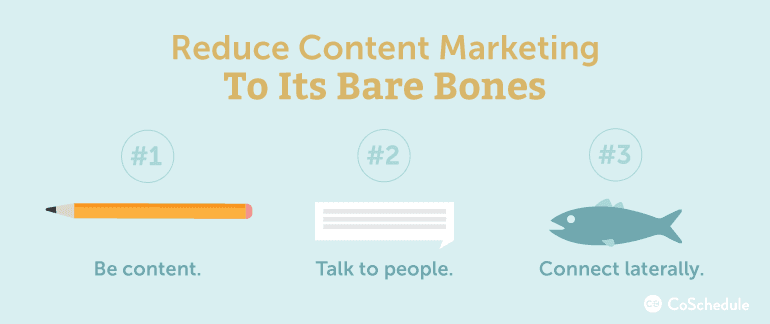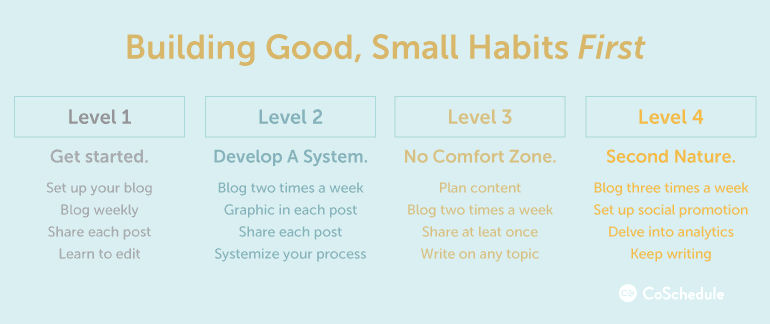What Is The Best Way To Do Marketing Solo When You Can’t Find Time?
 If team blogging advice is confusing you as a solo blogger, stop.
CoSchedule is a powerful blogging tool with definite team-tendencies, and we often blog with an eye toward teams of content marketers. But that may actually be unhelpful for a solo blogger. Though we write with an eye towards solo bloggers once in a while, too often we focus on the power of teams and create complex workflows and percentage-based approaches that can make even the best solo blogger’s eyes glaze over in despair.
If team blogging advice is confusing you as a solo blogger, stop.
CoSchedule is a powerful blogging tool with definite team-tendencies, and we often blog with an eye toward teams of content marketers. But that may actually be unhelpful for a solo blogger. Though we write with an eye towards solo bloggers once in a while, too often we focus on the power of teams and create complex workflows and percentage-based approaches that can make even the best solo blogger’s eyes glaze over in despair.
What Is The Best Way To Do Marketing Solo When You Can't Find Time? via @JulieNeidlinger
Click To TweetWhat Troubles The Solo Blogger?
Here are the characteristics of a solo blogger, from my own experience and from what we’ve heard from readers:- Busy
- Busy
- Busy
- No team to bounce ideas off
- No team to draft a long list of headlines to "test" for the best one
- No team to "review" the articles prior to publishing
- No "editor"
- No "graphics" person
- No team to handle social media, either in the posting (I use Buffer & Co-Schedule, of course), or in responding
- No team to do extensive research, either for "hot, trending" topics or background research
Marketing is just one thing on your to-do list. Here's how to do it well as a solo artist.
Click To TweetReduce Content Marketing To Its Bare Bones
 In the great swell of content marketing, with all of the graphics, stats, charts, tools, and theories, one thing has probably been lost: At its bare bones, content marketing is simply about writing stuff people want to read.
In the great swell of content marketing, with all of the graphics, stats, charts, tools, and theories, one thing has probably been lost: At its bare bones, content marketing is simply about writing stuff people want to read.
At its bare bones, #contentmarketing is simply about writing stuff people want to read.
Click To Tweet1. The first word of content marketing is “content.”
Be content with content. Yes, there is social media. Yes, there are email lists. Yes, there are analytics and A/B testing and landing pages and all kinds of other things under the sun that promise and deliver great returns. But, at its base, it is simply about writing something good. If you were to do that, search engines will find you. People will find you. It might be at a much slower rate, but they will. There is this huge fear—likely based on the heavy importance of big numbers as proof of successful content marketing—of how to exist when no one is reading your blog. This is horribly stifling when you’re getting started and trying to build good habits. Learn to write content well, quickly, and as second nature.2. Just talk to people. All kinds.
Here’s a shocker: I get lots of tweets and retweets and shares and followers on Twitter for the things I write, but the most viable return I receive is when I go to a blog and just leave a useful comment or establish a person-to-person communication with someone else online. And no, these are not always content marketing blogs. They are cartooning blogs, art blogs, fountain pen blogs, philosophy blogs—interesting people, great conversation, and I’ve made business connections and networks through this. These are the true word-of-mouth social shares and links that translate into dedicated readers and customers.Talking to people, especially those outside your niche, can inspire a lot of creative marketing.
Click To Tweet3. Build connections laterally.
Content marketers sometimes get so wrapped up in content marketing and all of its peripherals that the engagement I get from them are questions on how they can do it better or almost mechanized retweets because they are trying to meet a curation quota. There is a strong focus that to get traction you must latch onto the influencers, the big or established names, but the response there is often an echo chamber. Find some other “little fish” and get real responses and build connections laterally instead of always looking vertically. Go where everyone else isn’t. You would be better off remembering to simply write great content and find interesting people and strike up long-term conversations on their blogs or social media accounts. The returns aren’t as sexy at first, but this approach helps you build the habit and get in practice. And, surprisingly, you make some worthwhile connections that can ultimately help your business in the long run.Building Good, Small Habits First
 The real question behind all the questions is probably this one: how do you get things done when you are busy and there is no one else to help?
The answer is not surprising: We can get more done when we do one thing at a time and are operating mostly out of habit (good ones). And you can’t form the big habit until you form the small one.
So let’s break it down into levels, with each level looking to form the habits you need in place before the next one. You might be at the beginning, or you might be further along. The key is that you can’t leave a level until all of the habits in the level are firmly in place.
Solo Blogging Level 1:
Just get started.
The real question behind all the questions is probably this one: how do you get things done when you are busy and there is no one else to help?
The answer is not surprising: We can get more done when we do one thing at a time and are operating mostly out of habit (good ones). And you can’t form the big habit until you form the small one.
So let’s break it down into levels, with each level looking to form the habits you need in place before the next one. You might be at the beginning, or you might be further along. The key is that you can’t leave a level until all of the habits in the level are firmly in place.
Solo Blogging Level 1:
Just get started.
- Set up your blog and learn basics of maintaining and running it.
- Blog weekly.
- Share each blog post when you publish it.
- Learn to fine tune your words and write without lots of errors.
- Blog two times a week.
- Every post must have a graphic.
- Share each post when you publish it.
- Figure out how you blog, and systemize it.
- Plan your content on an editorial calendar.
- Blog two times a week
- Share at least once on social media.
- Be able to write a blog post on any topic, even if you have no prior understanding or idea of how to approach it.
- Blog three times a week.
- Set up your social promotion plan.
- Delve into your analytics and learn to understand and use them.
Using A Triage Mentality
With a content marketing team, you can take in all of the great advice out there and implement it by delegating it out. From graphics to constant engagement and response on Twitter, it’s all doable. If you’re solo, you probably can’t. Remember, most solo bloggers are doing more than just content marketing. They are running other aspects of their business. My advice is to approach all of the helpful tips with a triage mentality, learning to pick what is the most important for what it is you want to accomplish, and leave the others alone. When you see a post about the “15 Most Important Things You Must Do For Your Content Marketing”, read it and decide which one or two you can actually do well and that will fit your ultimate goal.To do #contentmarketing solo, pick only the few things that you want to accomplish.
Click To Tweet- More traffic
- More readers
- More social media fans
- High social media shares
- Establish a reputation as an expert
Good advice that doesn’t apply to your goal is bad advice. #contentmarketing
Click To Tweet If you’re running a business and need to respond to customers sooner than once a week, I’d encourage you to at least set aside a chunk of time once a day to do it instead of hopping back and forth between social media conversation and content creation because I can guarantee you that that’s what’s creating a level of frustration and low productivity in you.
A triage mentality tells you to compartmentalize, do only the important things according to what is important to you, and tells you to do them one at a time. No multitasking nonsense.
If you’re running a business and need to respond to customers sooner than once a week, I’d encourage you to at least set aside a chunk of time once a day to do it instead of hopping back and forth between social media conversation and content creation because I can guarantee you that that’s what’s creating a level of frustration and low productivity in you.
A triage mentality tells you to compartmentalize, do only the important things according to what is important to you, and tells you to do them one at a time. No multitasking nonsense.
Real Life Example: What I Do
As both a solo blogger and a busy freelance blogger, my approach is one of limited resources and time.1. Prepare for the upcoming week.
On Sunday night, I sit down with my weekly planner and review and schedule the upcoming week’s work. All of the writing, blogging, etc. is planned out. CoSchedule lets you do this as well; I’m just a pen-and-paper fanatic. To make this work, you must be a realist. I know two long blog posts a day (or about 4,000 words total) is about all I can handle, so I certainly don’t set myself up for failure and schedule more than that. Set up a schedule you can handle.2. Triage upcoming tasks.
Using a highlighter, I decide which of these tasks for the coming week are absolute musts, and which are less important. I use color to make it easier to see. The low-hanging fruit, if not completed, gets moved to the next week or dropped altogether. If there are tasks continually not getting done after several weeks, it’s a sign I can’t handle it, the habit isn’t there, or it isn’t important. I have to rethink why I put them there, why I think I need to do them, or why I don’t seem motivated to complete them.3. Do the work.
There is a lot of fretting and productivity porn on the Internet where people are all trying to find the magic system for getting work done and being more productive. The truth is that such a solution doesn’t exist and fussing to find the perfect answer just keeps you from getting things done. No system is better than another, and they all hinge on one thing: you doing the work. If you’re struggling to write a blog post at your desk, write someplace else. Once a week I write at a coffee shop just to change things up a bit. If you’re struggling to write a blog post because you don’t want to, rethink why you are doing content marketing, or develop a kick-in-the-pants system that helps you get past this form of writer’s block. What tasks are you not getting done? Figure out why and work on finding a way to change that. You have to find the solution; I can’t tell you what to do.4. Periodically review what you’re doing.
Every month, I like to review:- My weekly planner and see what tasks I consistently didn’t finish.
- Traffic and stats for my blog and social media.
- How many words I write every week.
- The habits I’ve fallen into (both good and bad).
- If I’m practicing the habit of brainstorming and idea generation.
- How many books/magazines/newspapers I’m reading for non-online source material.
What Is The Answer?
 Let’s take a look at that original list from our over-worked solo blogger, and see what concrete solutions might be.
Let’s take a look at that original list from our over-worked solo blogger, and see what concrete solutions might be.
1. No team to bounce ideas off.
Trust your gut, read your analytics. Your analytics and social proof will tell you what idea they liked. Take the leap and write it and find out.2. No team to draft a list of headlines to test for the best one.
Dive in, write headlines, try again, and learn from both what gets shared the most as well as what you start to learn from all the practice. If you want more assurance than that, get a plugin like KingSumo Headlines that helps you pick the best headline automatically. Use our Headline Analyzer Studio. I don’t bounce headline ideas off of a team for my own blogging. I don’t write 25 headlines (though I usually write more than one). Some headlines are better than others. I move on.3. No team to review articles prior to publishing.
Practice writing and publishing, spell check, and reading a finished post out loud will help you write a good post. Believe me, if you have a typo or something amiss, online people will let you know. You will get better the more you do it. Don’t let a fear of no one there to reassure you the post is OK keep you from writing.4. No editor, or graphic designer.
Having an editor isn’t always the answer. Sometimes they over-edit. But if you’re concerned about the quality of your writing, there are options and apps to help you proofread. The blunt truth is, if you aren’t a good writer and you can’t afford to hire a writer, then content marketing is just going to be tough. Most people, though, can write to improve. It takes practice, and practice is the act of actually doing it. I don’t have an editor for my own blog. When I read my old blog posts I shudder. They got better the more I did it. No one is great right out of the gate. As far as graphics are concerned, Canva is a godsend. Social graphics, blog graphics, infographics—it does it all for free or low cost. Stock images are possible, but they can ding your budget. If you’re not a designer and want to avoid copyright issues, use Canva.5. No social media team for posting or responding.
Using CoSchedule and tools like Buffer make posting, re-posting, and curating very simple as long as you set aside the time and develop the habit. As far as responding, consider what I said about triage. Set aside time to respond, too, based on how important engagement is for your goal.6. No team to do research for topics or background.
There are all kinds of ways to get ideas for your blog. Hardcore research and diligent attention to trends is just one approach. As to writing your posts, not all of the blog post types are research intensive. If you can’t do research, focus on content types that don’t require it. While blog posts with headlines using the phrases “backed by science” or “backed by research” are very popular, you don’t have to write them. What are you good at? What can you write? Write what you can, not what everyone else is writing. You have stories to tell from client experiences. You have life experiences to share. You get ideas from books and articles you’ve read. You have reactions and comments on other blog posts. You have other things you can write without delving into scientific journals to find brain scans that prove the color blue is better for blogs than yellow. Write in the way that fits your content creator type and your time, not in accordance with what every other content marketer is telling you to write. And don’t worry about trending topics. Those kinds of blog posts aren’t going to be evergreen, anyway.Don’t Drown In Advice
The nature of content marketing is that there is lots of content, and even though so much of it is helpful, if you are drowning in good advice, you are still drowning. Solo bloggers, especially, must learn to pick and choose according to a simple goal, learning to build both habits and the foundation for the next goal. They have to write how and with what they have at hand. It’s very much a creative process, finding ideas to write about with the tools and time available. A team can handle a multi-pronged attack. But if there is only one of you, you are really only capable of a single-pronged attack.How To Succeed At #Marketing Solo When You Don't Have Time
Click To Tweet

